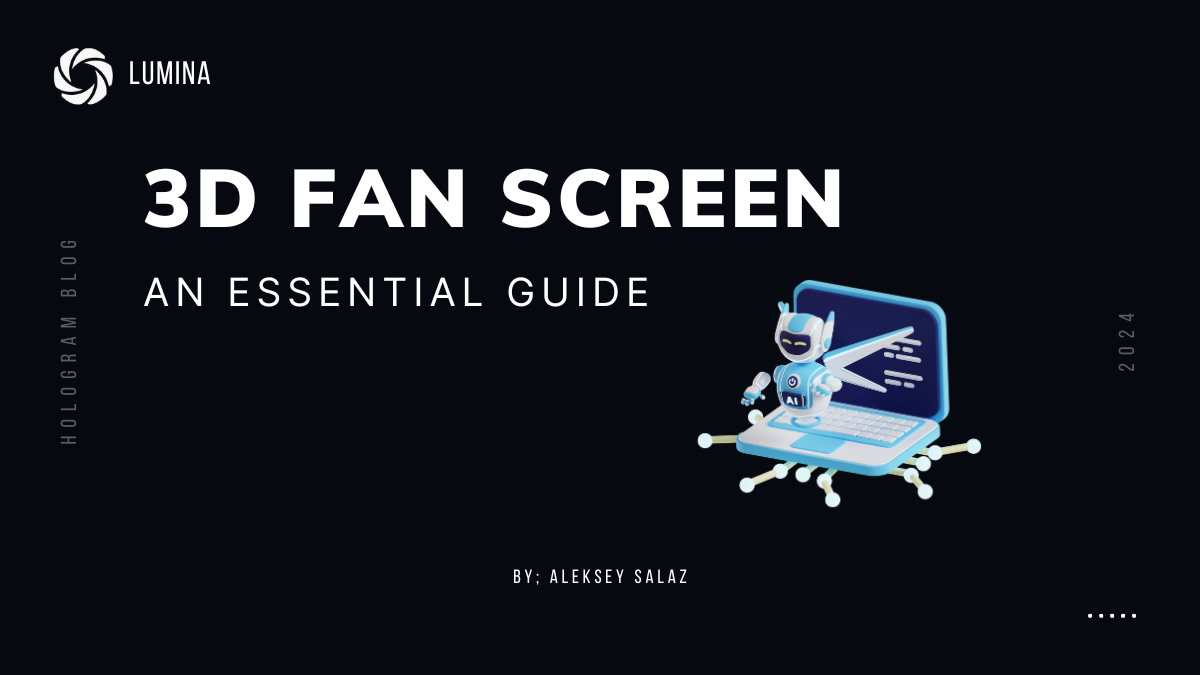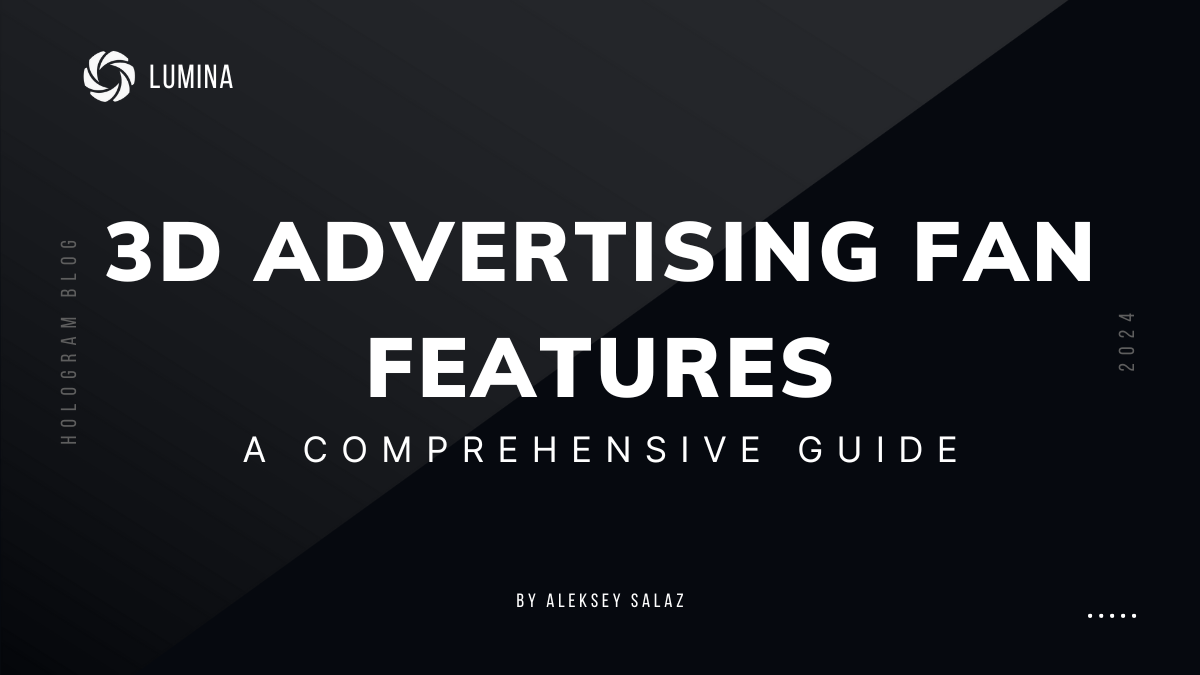Are you in search of ways to make your business stand out in a crowded market?
With the constant evolution in technology, the approach to advertising is changing.
As we strive to maintain our competitive edge in advertising, 3D fan screens have emerged as an exciting solution.
3D fan screen facts at a glance:
- Create floating 3D images
- Eye-catching and engaging
- Ideal for retail displays, trade shows and exhibitions
- Versatile across business, education and entertainment sectors
- Proven to increase customer engagement and drive sales
3D fan screens use cutting-edge technology that challenges conventional marketing norms. They manipulate LEDs and high-speed rotation to create captivating 3D images that literally appear to float in mid-air.
Powerful enough to grab attention instantly, these visuals offer a chance for your business to set a memorable interaction with the audience.
When grabbing customers' attention is becoming progressively difficult, 3D fan screens offer a way to break through the clutter. It's an innovative solution that's not just restricted to advertising and branding needs.
From schools to theme parks, they are being adopted to make learning more interactive and experiences more immersive.
Reflecting its effectiveness in application, top brands like Volkswagen and Starbucks have seen palpable results in customer engagement and sales, riding on the back of these 3D displays.
As we shift towards a more digital world, adoption of such unique display tools becomes less of a luxury and more of a necessity in achieving competitive superiority. Let's dive in to explore the potential of this exhilarating technology and how it could reshape the face of your business.
Understanding the Technology Behind 3D Fan Screens
In an ever-evolving digital world, it's important to understand the innovative technology that powers the captivating visual displays of 3D fan screens.
The science behind these devices might appear complex, but when broken down, it's fascinating how simple and ingenious it is.
How 3D Fan Screens Work
A 3D fan screen, often referred to as a 3D hologram fan, is essentially a fan embedded with LED lights on its blades.
This fan spins at a high speed, often exceeding 400 RPM (revolutions per minute), creating the illusion of a floating 3D image. This spinning action coupled with the rapid flashing of the LEDs synchronized with the fan's speed is what makes the magic happen.
A high-speed motor is responsible for spinning the fan blades, while a separate controller, often a microcontroller or a digital signal processor (DSP), manages the synchronization of the LED lights with the fan speed. This precise synchronization is the key to creating a captivating 3D image.

The Role of High-Speed Rotation and LEDs in Creating Holographic Images
The spinning LED lights on the fan blades play a significant role in creating vibrant, high-definition images. The high-speed rotation of the fan blades is what brings the animation to life.
When the fan spins at a speed of 750 revolutions per minute, it creates a stable and continuous image. This speed is carefully regulated to match the frame rate of the video content, ensuring a smooth and flicker-free display.
The use of RGB LEDs (Red, Green, Blue Light Emitting Diodes) in our fans also plays a crucial role. Capable of producing a wide spectrum of colors, they flash in a sequence at microsecond intervals, creating an array of colors that make up the final image.
The LEDs on the fan blades are placed strategically to display the video content as the fan spins, creating the illusion of a full-color video animation that is incredibly detailed and eye-catching.
The technology behind our 3D fan screens at Lumina is a game-changer. It's not just about projecting images; it's about creating an immersive visual experience that can captivate and engage your audience.
Whether you're a retailer looking to attract more customers, an event organizer wanting to create a memorable experience, or just someone who enjoys the thrill of cutting-edge technology, understanding the mechanics of a 3D fan screen opens up a world of possibilities.
Benefits of Using 3D Fan Screens
When it comes to customer engagement, standing out from the competition, and making learning exciting, 3D fan screens bring a unique edge to the table. Let's delve into the benefits of these innovative displays.
Enhancing Customer Engagement with 3D Fan Screens
In a digital world filled with constant visual stimulation, capturing the attention of your audience can be challenging. However, 3D fan screens, with their ability to create hyper-realistic visuals that appear to float in mid-air, offer a fascinating solution.
As one Reddit user aptly put it, these displays create a "naked eye 3D effect" that is simply amazing. This captivating visual experience encourages viewers to engage with the display, whether it's in a retail store, at a trade show, or in an educational setting.
This increased engagement can lead to stronger connections with your audience, whether they are customers, clients, or students.
Increasing Foot Traffic and Revenue with 3D Fan Screens
In the competitive business environment, a unique 3D display can help your business differentiate itself and attract more foot traffic. People are naturally drawn to things that are different and intriguing.
By showcasing products or services in a three-dimensional format that appears to float in the air, businesses can create a buzz and draw a crowd.
Moreover, the novelty and engagement factor of these displays potentially lead to higher sales. The cutting-edge technology not only attracts more viewers but also keeps them engaged longer, increasing the likelihood of converting interest into purchases.

Making Learning Exciting with 3D Fan Screens
Education is another area where 3D fan screens can shine. The ability to present information in a dynamic, visual, and interactive way can revolutionize how students learn.
Whether it's exploring the human anatomy in biology, visualizing complex mathematical shapes, or even bringing historical events to life, 3D fan screens can make education more engaging and exciting. This can lead to improved understanding and retention of information, making learning not just effective, but also fun.
At Lumina, we believe in the power of 3D fan screens to captivate audiences, stand out from the competition, and engage learners in new ways. The future of visual displays is here, and it's holographic.
Lumina's Unique 3D Fan Screens
At Lumina, we take pride in our 3D fan screens, which are designed to not just display, but to impress, engage, and captivate your audience.
We've mastered the art of 3D holography and integrated it into our fan screens, which offer distinct advantages over traditional display platforms.
Superior Processing Speed and Image Quality
Our most popular models of 3D fan screens have been upgraded to offer superior processing speed and image quality. These new and improved models feature HD images and 3D holographic effects, ensuring that your content comes to life in stunning 3D detail.
The precise timing of LED lights lining the blades of the fan in combination with high-speed rotation creates a mesmerizing "3D hologram" that hovers in mid-air, viewable to the naked eye.
Our 3D fan screens are equipped with high-quality, bright LED beads. These beads ensure that your images are highly visible in both light and dark settings, delivering exceptional HD video quality for any occasion or location.
Customizable 3D Effects
With Lumina's 3D fan screens, you have the power to customize your content to fit your specific needs. You can upload your favorite videos and watch them come to life in impressive 3D detail. This provides an opportunity to create unique and custom 3D displays that outperform traditional display platforms.
Whether you're looking to showcase a product, advertise a service, or simply entertain, our 3D fan screens offer the flexibility and creativity to make it happen. Additionally, we provide a free 3D video library with hundreds of animations ready to download when you place an order.
User-Friendly Interface for Uploading Videos
At Lumina, we understand that technology should simplify tasks, not complicate them. That's why our 3D fan screens come with a user-friendly mobile app that allows for easy upload and management of content directly from your phone.
Our app is compatible with both iOS and Android, allowing you to manage your content seamlessly from any device. With the tap of a finger, you can upload, manage, and customize your content, making the operation of your 3D fan screen as easy as possible.
In conclusion, Lumina's 3D fan screens offer a unique blend of technology and creativity, providing a captivating and engaging viewer experience. Whether in a retail store, trade show, or educational setting, our 3D fan screens are designed to impress, engage, and captivate your audience.
Other Types of Holographic Displays
While Lumina's 3D fan screens offer a captivating viewer experience, it's also beneficial to understand other types of holographic displays available in the market. This will allow you to appreciate the unique value that a 3D fan screen brings to your business or event.
Laser Plasma Displays
Laser plasma displays are a type of 3D holographic display that use powerful lasers to create plasma excitations with the oxygen and nitrogen molecules in the air.
This forms images in thin air, without the need for a screen or external refraction media. Despite their ability to depict bright and visible objects, laser plasma displays may fall short in terms of resolution and picture quality.
Micromagnetic Piston Displays
Invented by Belgian company IMEC in 2011, micromagnetic piston displays utilize a micro-electro-mechanical system (MEMS) structure. Thousands of microscopic pistons act as pixels, reflecting light with a desired wavelength to represent an image.
However, the high cost, difficulty of creating large screens, and mechanical failures due to the many moving parts can be significant limitations for this type of display.
Holographic Television Displays
Holographic television displays, created by MIT researcher Michael Bove in 2013, use a Microsoft Kinect camera to capture subjects in a three-dimensional space.
The image is then processed by a PC graphics card and replicated with a series of laser diodes. The resulting image is fully 3D and can be viewed from all angles providing a unique spatial perspective.
Touchable Holograms
Touchable holograms are an exciting development in the field of 3D displays. Originally a Japanese invention, this technology has been further advanced by companies like Intel.
Touchable holograms can detect a user's touch by sensing movements in the air. They then provide haptic feedback to the user by sending an ultrasonic air blast in return.
This type of display could have exciting applications in public kiosks, as it does not require a user to physically touch a screen, limiting the transmission of bacteria and viruses.
While these alternatives to 3D fan screens offer unique features, they also have their limitations in terms of cost, resolution, and maintenance.
On the other hand, Lumina's 3D fan screens provide a blend of high-quality visuals, cost-effectiveness, and ease of use, making them an ideal choice for businesses and event coordinators.
Customer Reviews of 3D Fan Screens
After understanding the various types of holographic displays, it's also important to know how people are responding to 3D fan screens. Sharing insights from actual users can give us a balanced perspective on the functionality and versatility of these devices.
Positive Feedback on Quality and Functionality
Many customers express their satisfaction with the quality of 3D fan screens. A user noted the superior image quality of the HD model, stating it was "well worth the money" and that the 3D imaging was "very good" (P***e, Aliexpress). Such feedback emphasizes the high-definition visuals that these screens can deliver.
Another user praised the functionality of the screens, mentioning the ease of uploading photos and videos through an application (A***s, Aliexpress). This reflects the user-friendly nature of these screens, making them accessible even to those who are not tech-savvy.
User Experiences with Different Types of Holographic Displays
Users are also impressed by the variety of displays that 3D fan screens can project. As one Reddit user put it, these displays create a "naked eye 3D effect" that is nothing short of amazing. This ability to captivate audiences makes 3D fan screens a powerful tool in advertising, marketing, and even education.
At Lumina, we strive to provide high-quality 3D fan screens that meet your needs. We are always delighted to hear positive feedback from our customers, and we are committed to continuously improving our products to provide you with the best possible visual experience.
As we conclude this section, user reviews are just one part of the story. Your specific needs and objectives should guide your decision. We recommend exploring our Product Page or contacting our customer support team for personalized advice.
Conclusion
Recap of the Importance and Benefits of 3D Fan Screens
In this guide, we've explored the fascinating world of 3D fan screens, a technology that's transforming how businesses, educators, and entertainers engage their audiences.
The allure of 3D fan screens lies in the ability to create hyper-realistic visuals that appear to float in mid-air, captivating audiences with a "naked eye 3D effect" (as described by a Reddit user) in a way that traditional displays simply can't match.
Furthermore, we've highlighted how our 3D fan screens can help businesses stand out in a crowded market, enhancing customer engagement and potentially boosting sales. In the educational sector, these devices can bring complex concepts to life, making learning more interactive and engaging. For the entertainment industry, 3D fan screens offer endless possibilities, enhancing stage performances and creating immersive environments.
Final Thoughts on Choosing the Right 3D Fan Screen
Choosing the right 3D fan screen for your needs is a crucial decision. You should consider the fan's speed, brightness, and viewing angle - all of which can greatly impact the effectiveness of the holographic display.
Another important factor is the display size. Larger display sizes can create bigger and more impactful visuals, but they also require more space and may be more expensive. It's essential to choose a fan with a display size that suits your specific needs and circumstances.
Finally, despite the advanced technology behind them, 3D fan screens are user-friendly.
Setting up a holographic display is relatively straightforward, and we at Lumina offer a variety of services, from the creation of custom 3D models to the rental or purchase of holographic fans, making it easy for anyone to benefit from this innovative technology.
In conclusion, 3D fan screens represent the future of visual displays. They offer a unique and engaging way to capture audiences' attention, making them an invaluable tool for businesses, educators, and entertainers.
To explore more about how these devices can benefit your business or event, visit our Hologram Blog or contact us for personalized advice.


